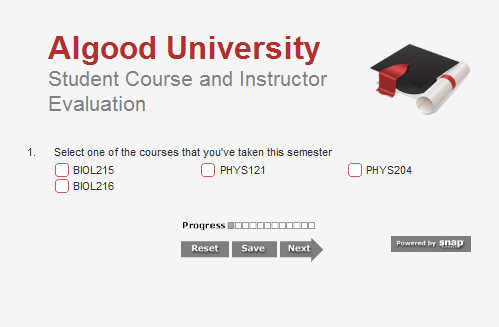Common features of an online course evaluation and 5 tips you can use to increase course evaluation response rates
There is no surprise that there has been an increased growth in the use of survey software for online course evaluations. Many colleges and universities have acquired integrated survey software systems that take a hybrid approach to survey administration, offering a choice of paper, online, or mobile survey administration. This allows higher education survey researchers to better match the method of survey administration to the needs and preferences of respondents.
Common features of an online course evaluation involve:
- Giving students assurance that their responses will be unidentifiable and that aggregate reports will be made available only after final grades have been determined;
- Providing students with a URL to access the evaluation—generally using their student ID number or other unique identifier to log-in to the evaluation;
- Students selecting options to single and multiple response questions, and typing answers to open-ended questions;
- Providing students with a confirmation page verifying that they have completed the evaluation; and
- Providing at least one to two weeks in which the students can respond, usually near the end of a semester.
Online course evaluations give students more flexibility in completing evaluations than paper-based surveys do. Will response rates drop when course evaluations are moved online? This is a common concern of many institutions. The short answer – response rates may drop at first. However, over time, administering online course evaluations will help provide institutions with better quality data, reduced completion time, and increased response rates.
Here are 5 tips to increase online course evaluation response rates
1. Keep an open line of communication with students.
- Guarantee anonymity by stating that the information collected from evaluations will remain confidential.
- Communicate when the evaluation process will begin and provide clear instructions for completion.
- Explain how the information from course evaluations will be used – how it will benefit the student, the course, the instructor, and the institution as a whole.
- Highlight the value of participation by sharing examples of how student feedback from past evaluations has turned into recognizable outcomes.
2. Broadcast your online course evaluations across all area of your institution.
- Direct campus-wide e-mail campaign.
- Banner ads on online student portals.
- Ads in online and print student publications.
- Daily notifications via social media: Facebook, Twitter, LinkedIn, etc.
- Eye-catching messages on posters, flyers, and other printed materials throughout campus.
3. Offer incentives to encourage course evaluation participation.
- Share course evaluation results with all students who complete their evaluations.
- Consider making the course evaluation a mandatory assignment within the course.
- Present a small grade increase or extra credit. (Who doesn’t like extra credit?!)
- Give students who complete their evaluations early access to exam and final grades.
- Give students access to their grades once they have completed their course evaluations.
- Grant students who complete their evaluations early, advanced access to exam and final grades.
4. Don’t make the course evaluation process complicated.
- Explain to student how to access online course evaluations. Let students know the variety of ways they can access the evaluation, including on PCs and laptops. If your survey software provider has the capability of adapting to any screen size, ensure that students understand that they can access evaluations on mobile devices such as tablets and Smartphones.
- Efficiently design course evaluations so that they are a manageable length, comprehensible, and easy to complete.
- Provide a link to course evaluation(s) in emails sent to students as well as set-up auto reminder messages to remind students to complete evaluations.
- Encourage students to bring laptops and mobile devices to class.
5. Send reminders to ensure students complete evaluations
- Send out early invitations to students, ideally 2 to 3 weeks in advance of the scheduled evaluations.
- Send email reminders during the evaluation period, ideally every 3 to 5 days, until the evaluations are complete.
- Ensure instructors reiterate the importance of student feedback and participation during the final weeks of the semester.
- Send reminders via a direct campus-wide e-mail campaign.
- Set reminders on banner ads on online student portals.
- Send daily reminder notifications via social media: Facebook, Twitter, LinkedIn, etc.
What has your institution done to increase course evaluation response rates? Please share with us in the comments below.



